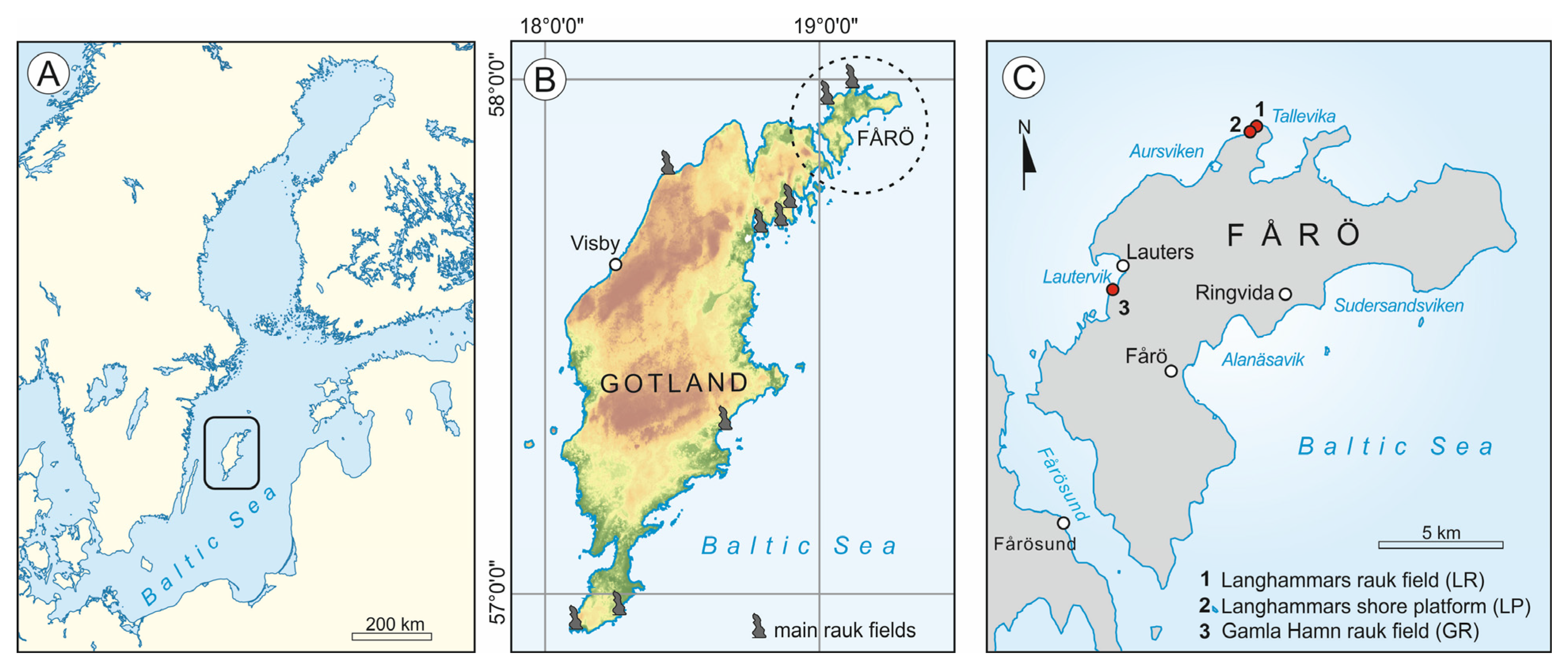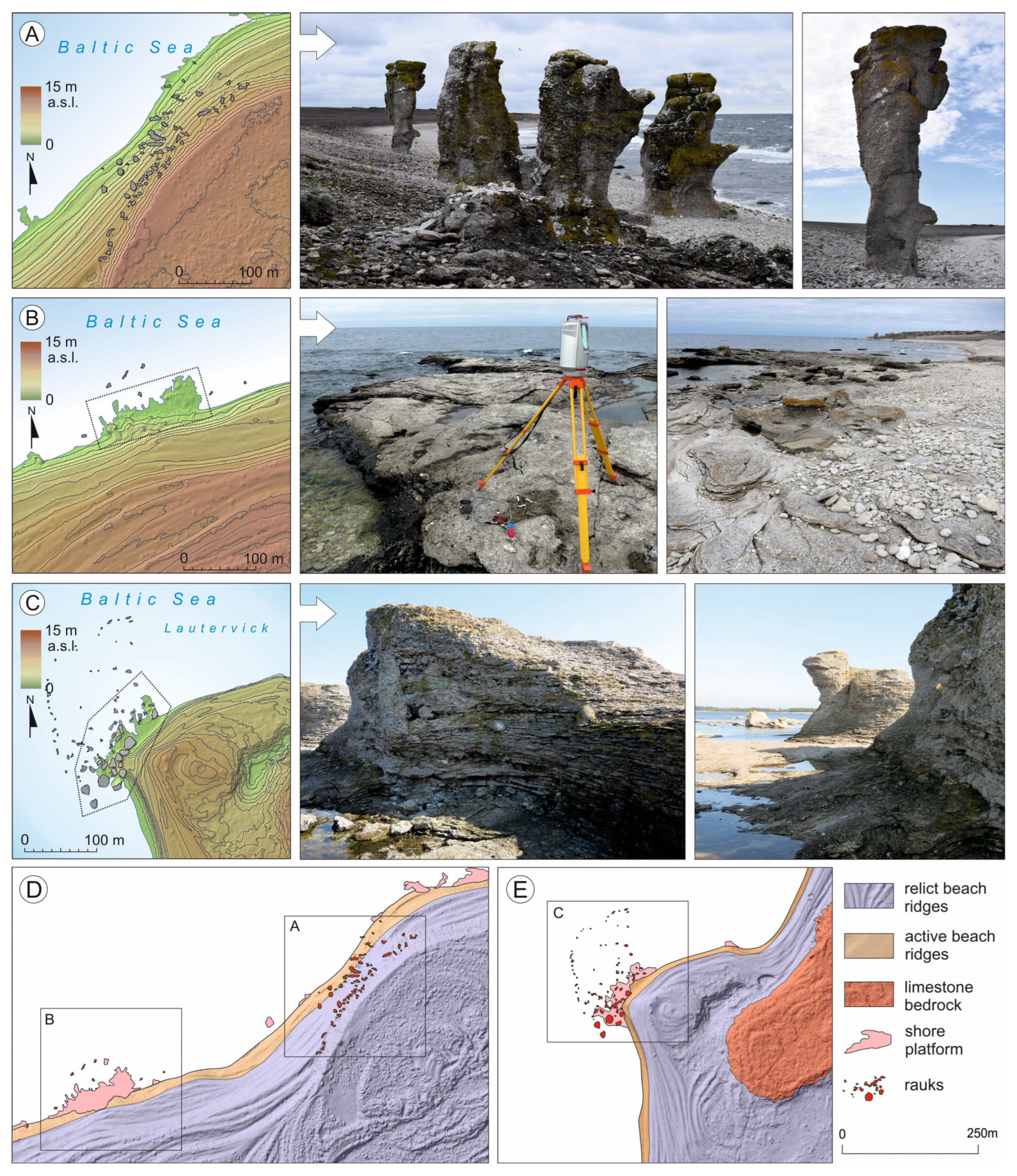Terrestrial Laser Scanning for the Detection of Coastal Changes along Rauk Coasts of Gotland, Baltic Sea
Abstract
:1. Introduction
2. Materials and Methods
2.1. Study Side
2.2. Data Acquisition
2.2.1. Equipment, Field Campaigns, and Post-Processing
2.2.2. Thermal Conditions
3. Results
3.1. Changes within Rauks Built of Massive, Homogeneous Limestone (Occurring at the LR Site)
3.2. Changes in the Rock Surface of Rauks Built from Laminated Limestone (GR Site)
3.3. Changes across Shore Platform
3.4. Frost Weathering
4. Discussion—Rauk Evolution Concept in Light of TLS
5. Conclusions
- Through the use of TLS, the magnitude of contemporary changes on rauk coasts has been assessed for the first time on a seasonal basis at a high, sub-centimetre resolution, enabling an assessment of its current erosion rate and degradation.
- No significant changes were observed in all the examined notches of rauks built of massive, homogeneous limestone. Slight transformations were visible from the notches on strongly weathered rauk surfaces where 0.5–1.0 centimetre-thick surface layers were flaking off. The bigger changes were detected on the surface of rauks built from laminated limestone. Here, up to 2–5 centimetre-wide and 20–30-centimetre-long rock fragments were falling from the rauks, leaving ca. 3–8 cm deep hollows and cracks. On shore platforms, we mapped the erosion of limestone slabs up to 3–4 cm thick and more than 50 cm long.
- TLS enabled a spatial assessment of the amount and magnitude of changes within the Fårö and Gotland rauk fields, placing them against the area’s diverse geology and the geomorphological processes transforming it.
- The results support the conceptual model of rauk coast evolution presented by [17].
- The TLS measurements carried out constitute the first such detailed documentation of the rauk fields in the Baltic region, providing a starting point for future analyses of land stability and erosional and weathering patterns in a warmer future. The data obtained in TLS surveys constitute a digital archive of the rauk coast landscape, and should support future coastal monitoring and geoheritage studies.
Author Contributions
Funding
Data Availability Statement
Acknowledgments
Conflicts of Interest
References
- Migoń, P.; Duszyński, F.; Goudie, A. Rock cities and ruiniform relief: Forms—processes—terminology. Earth-Sci. Rev. 2017, 171, 78–104. [Google Scholar] [CrossRef]
- Migoń, P.; Duszyński, F. Ruiniform Relief. In Treatise on Geomorphology, 2nd ed.; Shroder, J., Ed.; Academic Press: Cambridge, MA, USA, 2022; pp. 408–431. [Google Scholar]
- Rooke, H. Some account of the Brimham Rocks in Yorkshire. Archaeologia 1787, 8, 1–9. [Google Scholar]
- Pennant, T. A Tour from Alston-Moor to Harrogate, and Brimham Crags; Mercier and Co.: London, UK, 1804; p. 130. [Google Scholar]
- Eliason, S.; Bassett, M.G.; Willman, S. Geotourism Highlights of Gotland; NGO GEOGuide Baltoscandia: Tallin, Estonia, 2010; pp. 5–41. [Google Scholar]
- Linnaeus, C. Ölandska Och Gotländska Resa Pa Riksens Högloflige Ständers Befallning Förrättad Ahr 1741. In Gotländska Resaflrrattad 1741; Naturoch Kultur: Stockholm, Sweden,, 1745; p. 187. [Google Scholar]
- Murchison, R.I. On the Silurian and Associated Rocks in Dalecarlia, and on the Succession from Lower to Upper Silurian in Smoland, öland, and Gothland, and in Scania. Q. J. Geol. Soc. 1847, 3, 1–48. [Google Scholar] [CrossRef] [Green Version]
- Munthe, H. Sveriges Raukar Jamte Exempel Pa Pseudoraukar. Sver. Geol. Unders. Ser. C 1921, 303, 1–39. [Google Scholar]
- Manten, A.A. Some middle silurian reefs of gotland. Sedimentology 1962, 1, 211–234. [Google Scholar] [CrossRef]
- Kershaw, S. The Silurian geology of Gotland, Sweden. Geol. Today 1993, 9, 187–190. [Google Scholar] [CrossRef]
- Watts, N.R.; Riding, R. Growth of rigid high-relief patch reefs, Mid-Silurian, Gotland, Sweden. Sedimentology 2000, 47, 979–994. [Google Scholar] [CrossRef]
- Björck, S. A review of the history of the Baltic Sea, 13.0-8.0 ka BP. Quat. Int. 1995, 27, 19–40. [Google Scholar] [CrossRef]
- Berglund, B.E.; Sandgren, P.; Barnekow, L.; Hannon, G.; Jiang, H.; Skog, G.; Yu, S.-Y. Early Holocene history of the Baltic Sea, as reflected in coastal sediments in Blekinge, southeastern Sweden. Quat. Int. 2005, 130, 111–139. [Google Scholar] [CrossRef]
- Forsberg, P. Geomorfologiska Studier Av Kustplattformen Utmed Gotlands Nordvästra Klintkust. Univ. Stockholm Dep. Phys. Geography. Forsk. 1995, 101, 74. [Google Scholar]
- Erlström, M.; Persson, L.; Sivhed, U.; Wickström, L. K 221 Beskrivning till Regional Berggrundskartaöver Gotlandslän; Sveriges Geologiska Undersökning: Uppsala, Sweden, 2009; pp. 5–60. [Google Scholar]
- Strzelecki, M.C.; Duszyński, F.; Tyszkowski, S.; Zbucki, Ł.; Kasprzak, M. Rauk—A Forgotten Witness of Holocene Sea-level Change and Development of Baltic Rocky Coasts: A Pilot Geomorphological Study in Lergrav Raukar Field. J. Coast. Res. 2020, 95, 659–663. [Google Scholar] [CrossRef]
- Strzelecki, M.C.; Duszyński, F.; Tyszkowski, S.; Zbucki, Ł. Limestone Sea Stacks (Rauks) Record Past Sea Levels and Rocky Coast Evolution in the Baltic Sea (Gotland and Fårö Islands, Sweden). Front. Earth Sci. 2022, 10. [Google Scholar] [CrossRef]
- Manten, A.A. Silurian Reefs of Gotland; Elsevier: Amsterdam, The Netherlands, 1971; 539p. [Google Scholar]
- Johansson, A.E. Geomorfologisk Klassificering Och Kartering Av Fårö Kust, Gotland. Kulturgeografiska Inst. 2017, 44. [Google Scholar]
- Rudberg, S. The Cliff Coast of Gotland and the Rate of Cliff Retreat. Geogr. Ann. Ser. A Phys. Geogr. 1967, 49, 283–298. [Google Scholar] [CrossRef]
- Cruslock, E.M.; Naylor, L.A.; Foote, Y.L.; Swantesson, J.O. Geomorphologic equifinality: A comparison between shore platforms in Höga Kusten and Fårö, Sweden and the Vale of Glamorgan, South Wales, UK. Geomorphology 2010, 114, 78–88. [Google Scholar] [CrossRef]
- Calligaro, S.; Sofia, G.; Prosdocimi, M.; Fontana, G.D.; Tarolli, P. Terrestrial laser scanner data to support coastal erosion analysis: The conero case study. Isprs Int. Arch. Photogramm. Remote Sens. Spat. Inf. Sci. 2013, XL-5/W3, 125–129. [Google Scholar] [CrossRef] [Green Version]
- Tyszkowski, S.; Kaczmarek, H.; Linowski, S.; Marszelewski, W. Testing of differential elevation models based on combined airborne and long-range terrestrial laser scanning for assessment of river bank erosion. Geogr. Pol. 2017, 90, 493–498. [Google Scholar]
- Rączkowska, Z.; Cebulski, J. Quantitative assessment of the complexity of talus slope morphodynamics using multi-temporal data from terrestrial laser scanning (Tatra Mts., Poland). Catena 2022, 209, 105792. [Google Scholar] [CrossRef]
- Cebulski, J. Impact of river erosion on variances in colluvial movement and type for landslides in the Polish Outer Carpathians. Catena 2022, 217, 106415. [Google Scholar] [CrossRef]
- Abellán, A.; Oppikofer, T.; Jaboyedoff, M.; Rosser, N.J.; Lim, M.; Lato, M.J. Terrestrial laser scanning of rock slope instabilities. Earth Surf. Process. Landforms 2013, 39, 80–97. [Google Scholar] [CrossRef]
- Tyszkowski, S.; Kaczmarek, H.; Linowski, S.; Kozyreva, E. Analysis of river bank erosion by combined airborne and long-range terrestrial laser scanning: Preliminary results on the vistula river. Geodyn. Tectonophys. 2018, 9, 249–261. [Google Scholar] [CrossRef]
- Dewez, T.J.; Rohmer, J.; Regard, V.; Cnudde, C. Probabilistic coastal cliff collapse hazard from repeated terrestrial laser surveys: Case study from Mesnil Val (Normandy, northern France). J. Coast. Res. 2013, 65, 702–707. [Google Scholar] [CrossRef]
- Esposito, G.; Salvini, R.; Matano, F.; Sacchi, M.; Danzi, M.; Somma, R.; Troise, C. Multitemporal Monitoring of a Coastal Landslide through SfM-Derived Point Cloud Comparison. Photogramm. Rec. 2017, 32, 459–479. [Google Scholar] [CrossRef] [Green Version]
- Schneiderwind, S.; Boulton, S.; Papanikolaou, I.; Reicherter, K. Innovative tidal notch detection using TLS and fuzzy logic: Implications for palaeo-shorelines from compressional (Crete) and extensional (Gulf of Corinth) tectonic settings. Geomorphology 2017, 283, 189–200. [Google Scholar] [CrossRef]
- Lim, M.; Strzelecki, M.C.; Kasprzak, M.; Swirad, Z.M.; Webster, C.; Woodward, J.; Gjelten, H. Arctic rock coast responses under a changing climate. Remote Sens. Environ. 2020, 236, 111500. [Google Scholar] [CrossRef]
- Westoby, M.; Lim, M.; Hogg, M.; Dunlop, L.; Pound, M.; Strzelecki, M.; Woodward, J. Decoding Complex Erosion Responses for the Mitigation of Coastal Rockfall Hazards Using Repeat Terrestrial LiDAR. Remote Sens. 2020, 12, 2620. [Google Scholar] [CrossRef]
- Ossowski, R.; Przyborski, M.; Tysiac, P. Stability Assessment of Coastal Cliffs Incorporating Laser Scanning Technology and a Numerical Analysis. Remote Sens. 2019, 11, 1951. [Google Scholar] [CrossRef] [Green Version]
- Svantesson, S.I. Beskrivning till jordartskartan: Gotland; Sveriges Geologiska Undersökning: Uppsala, Sweden, 2008; pp. 1–48. [Google Scholar]
- Boelhouwers, J.; Andersson, C.; Berg, R.; Kandastar, R.A.; Sjöman, A.; Lindgren, E.V. Long-term frost weathering rates of limestone beach clasts, Fårö Island, Central Baltic Sea. Geogr. Ann. Ser. A Phys. Geogr. 2020, 102, 12–32. [Google Scholar] [CrossRef]
- Tyszkowski, S.; Cebulski, J. Practical aspects of landslides surveys using terrestrial laser scanning in diverse geomorphological terrains: Case studies from Polish Carpathians and Lower Vistula Valley. Z. Geomorphol. 2019, 62, 107–124. [Google Scholar] [CrossRef]
- Feistel, R.; Weinreben, S.; Wolf, H.; Seitz, S.; Spitzer, P.; Adel, B.; Nausch, G.; Schneider, B.; Wright, D.G. Density and Absolute Salinity of the Baltic Sea 2006–2009. Ocean Sci. 2010, 6, 3–24. [Google Scholar] [CrossRef] [Green Version]
- Rosser, N.; Petley, D.; Lim, M.; Dunning, S.; Allison, R. Terrestrial laser scanning for monitoring the process of hard rock coastal cliff erosion. Q. J. Eng. Geol. Hydrogeol. 2005, 38, 363–375. [Google Scholar] [CrossRef]
- Roulland, T.; Maquaire, O.; Costa, S.; Medjkane, M.; Davidson, R.; Fauchard, C.; Antoine, R. Seasonal activity quantification of coast badlands by TLS monitoring over five years at the “Vaches Noires” cliffs (Normandy, France). Geomorphology 2022, 400, 108083. [Google Scholar] [CrossRef]
- Kociuba, W. Analysis of geomorphic changes and quantification of sediment budgets of a small Arctic valley with the application of repeat TLS surveys. Z. Geomorphol. Supp. Issues 2017, 61, 105–120. [Google Scholar] [CrossRef]
- Kociuba, W. Different Paths for Developing Terrestrial LiDAR Data for Comparative Analyses of Topographic Surface Changes. Appl. Sci. 2020, 10, 7409. [Google Scholar] [CrossRef]
- Kaczmarek, H.; Tyszkowski, S.; Bartczak, A.; Kramkowski, M.; Wasak, K. The role of freeze-thaw action in dam reservoir cliff degradation assessed by terrestrial laser scanning: A case study of Jeziorsko Reservoir (central Poland). Sci. Total Environ. 2019, 690, 1140–1150. [Google Scholar] [CrossRef]
- Harishidayat, D.; Al-Shuhail, A.; Randazzo, G.; Lanza, S.; Muzirafuti, A. Reconstruction of Land and Marine Features by Seismic and Surface Geomorphology Techniques. Appl. Sci. 2022, 12, 9611. [Google Scholar] [CrossRef]
- Shepard, F.P.; Kuhn, G.G. History of Sea Arches and Remnant Stacks of La Jolla, California, and Their Bearing on Similar Features Elsewhere. Mar. Geol. 1983, 51, 139–161. [Google Scholar] [CrossRef]
- Trenhaile, A.S.; Pepper, D.A.; Trenhaile, R.W.; Dalimonte, M. Stacks and Notches at Hopewell Rocks, New Brunswick, Canada. Earth Surf. Process. Landforms 1998, 23, 975–988. [Google Scholar] [CrossRef]
- Limber, P.W.; Murray, A.B. Sea stack formation and the role of abrasion on beach-mantled headlands. Earth Surf. Process. Landforms 2014, 40, 559–568. [Google Scholar] [CrossRef]
- Bezore, R.; Kennedy, D.M.; Ierodiaconou, D. The Drowned Apostles: The Longevity of Sea Stacks over Eustatic Cycles. J. Coast. Res. 2016, 75, 592–596. [Google Scholar] [CrossRef]












| Langhammars—Rauk Field (LR) | Langhammars—Shore Platform (LP) | Gamla Hamn (GR) | |
|---|---|---|---|
| Study area [m2] | 30,000 | 15,000 | 12,000 |
| Number of scan positions–Leica scanner | 5 | 4 | 4 |
| Number of scan positions–Riegl scanner | 14 | 8 | 12 |
| Resolution: theta/phi angle | 0.04/0.04 panorama 0.003/0.02 selected areas | 0.05/0.06 panorama 0.003/0.02 selected areas | 0.05/0.06 panorama 0.003/0.02 selected areas |
Disclaimer/Publisher’s Note: The statements, opinions and data contained in all publications are solely those of the individual author(s) and contributor(s) and not of MDPI and/or the editor(s). MDPI and/or the editor(s) disclaim responsibility for any injury to people or property resulting from any ideas, methods, instructions or products referred to in the content. |
© 2023 by the authors. Licensee MDPI, Basel, Switzerland. This article is an open access article distributed under the terms and conditions of the Creative Commons Attribution (CC BY) license (https://creativecommons.org/licenses/by/4.0/).
Share and Cite
Tyszkowski, S.; Zbucki, Ł.; Kaczmarek, H.; Duszyński, F.; Strzelecki, M.C. Terrestrial Laser Scanning for the Detection of Coastal Changes along Rauk Coasts of Gotland, Baltic Sea. Remote Sens. 2023, 15, 1667. https://doi.org/10.3390/rs15061667
Tyszkowski S, Zbucki Ł, Kaczmarek H, Duszyński F, Strzelecki MC. Terrestrial Laser Scanning for the Detection of Coastal Changes along Rauk Coasts of Gotland, Baltic Sea. Remote Sensing. 2023; 15(6):1667. https://doi.org/10.3390/rs15061667
Chicago/Turabian StyleTyszkowski, Sebastian, Łukasz Zbucki, Halina Kaczmarek, Filip Duszyński, and Mateusz C. Strzelecki. 2023. "Terrestrial Laser Scanning for the Detection of Coastal Changes along Rauk Coasts of Gotland, Baltic Sea" Remote Sensing 15, no. 6: 1667. https://doi.org/10.3390/rs15061667






